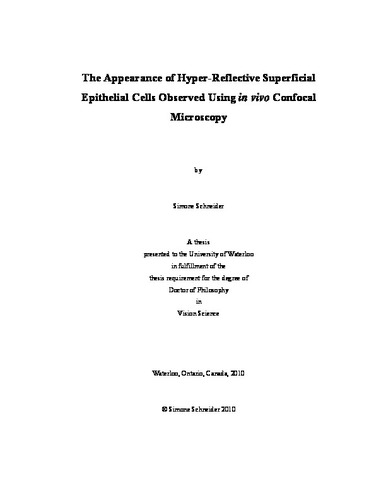| dc.description.abstract | Purpose:
Hyper-reflective superficial cells were an unexpected finding while examining the corneal epithelium using confocal microscopy (CM), during an MSc thesis conducted in 2006 at the University of Waterloo, Canada. The author1 suggested that the appearance of these hyper-reflective cells could be associated with solution induced corneal staining (SICS) that was also observed in those participants who had manifested these hyper-reflective cells. However, this hypothesis has not been reported in the literature. This thesis aimed to investigate variables that could possibly predict the appearance of hyper-reflective superficial cells. These investigated variables were the effect of: contact lenses, contact lens solutions, lens/solution combinations, long-term use of certain contact lenses and solutions, age, dry eye symptom, topical anaesthetics and sodium fluorescein. In addition to this, the normal superficial epithelium of controls was defined.
Methods:
CM images of the superficial epithelium were obtained during the various experiments from: 32 non-contact lens wearing participants, 18 post-menopausal participants symptomatic of dry eye and 18 post-menopausal age-matched asymptomatic women and 147 adapted soft contact lens wearers. For one experiment CM was performed with the contact lens in situ, making the use of a topical anaesthetic unnecessary. Superficial cellular appearance of CM images was graded using a custom grading scale. Hyper-reflective cells were counted. Corneal staining was assessed using sodium fluorescein.
Results:
Results obtained during the various experiments revealed that hyper-reflective cells predominately appeared with the use of a specific lens/solution combination. Also, the number of hyper-reflective cells peaked after two hours of lens wear. It was also shown that when hyper-reflective cells occurred during an experiment, not every participant who was exposed to that specific lens/solution combination manifested hyper-reflective cells. Also, a great deal of inter-subject variability in observed numbers of hyper-reflective cells was noted.
Conclusion:
In conclusion, this thesis established that the hyper-reflective cells that were observed by Harvey were reproducible and may co-occur with corneal staining induced by a specific lens/solution interaction | en |

